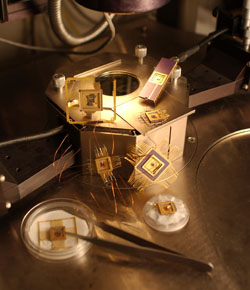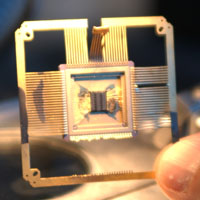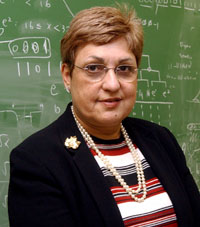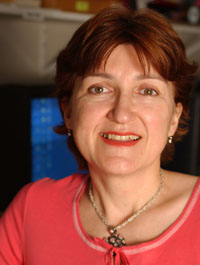Mighty MEMS
Microtechnology brings much more to the table than
its size.
By Kathleen Kocks

|

Julie Woodford
|
Housed at Tompkins Hall within GW’s Department
of Electrical and Computer Engineering, the Institute
of MEMS and VLSI Technologies is participating in an
industrial revolution that is fundamentally changing
the electromechanical world. Breakthrough research and
developments here are inventing micro-electro-mechanical
systems (MEMS)—machines that are infinitesimally
small, extremely smart, and rapidly becoming as ubiquitous
as computer chips.
MEMS is considered an enabling technology that is creating
new products and capabilities for nearly every industrial
area. These devices can perform a seemingly infinite
number of optical, electrical, computational, thermal,
mechanical, hydraulic, or pneumatic tasks—and more.
More than 10 times smaller than a human hair’s
diameter and typically embedded onto a computer chip,
MEMS devices have the intelligence to collect and process
information, determine what to do, and send electronic
signals to effect the action.
Where can MEMS devices can be used? Virtually anyplace.
Prevalent applications today include read/write magnetic
heads for computer hard drives, inkjet printer micro-nozzles,
airbag system accelerometers, tire-pressure sensors,
micro-mirror switches, blood pressure sensors, wireless
devices, and more.
One exciting area ripe for MEMS is the biomedicine field.
In the future, MEMS-based biosensors will be small enough
to be inserted in the body to measure such factors as
blood pressure and enzyme levels.
 
Julie Woodford
|
|
According to a 2004 survey by the MEMS Industry Group
MIG, the major revenue streams for MEMS devices by 2007
will be micro-fluidics (27 percent), inertial sensors
(22 percent), optical MEMS (22 percent), pressure sensors
(11 percent), other sensors (10 percent), other actuators
(5 percent), and radio frequency MEMS (3 percent). It
is also estimated that about 1.6 MEMS devices are already
in service for every one person in the United States.
Products being developed at GW’s MEMS institute
will increase that number. One development, funded in
part by a U.S. Naval Research Laboratory grant, is a
MEMS device developed by recent GW doctoral engineering
graduate Ioana Voiculescu, DSci ’05. The device,
for which a patent is being sought, can sniff out various
chemicals that even a bloodhound’s nose would miss.
A prime application for this unique MEMS is detection
of molecular traces of explosive chemicals or nerve gases,
far better than current state-of-the-art equipment.
“We are also working on MEMS devices for mobile
phones and for HF communications; the MEMS device could
replace quartz digital crystals that are currently used
in phones and radios. We are presently testing and hoping
to get another patent for a MEMS device being developed
by two or three students; it would be used to make the
cell phone smaller or more capable of performing more
functions. I’m very excited about these products
and am hoping to get some of them commercialized,” says
Mona E. Zaghloul, the institute’s founder and professor
within GW’s Electrical and Computer Engineering
Department within the School of Engineering and Applied
Science.
“We have many other types of developments underway.
All our research is supported by grants, and we are fortunate
to have research funding from several outside sources.
Some of our supporters include the National Institute
of Standards and Technology, the NRL, and NASA. I also
have many grant proposals out right now. For one grant,
we are planning to develop MEMS power sensors to be used
on electrical power grids. These would be able to measure
power loads, determine if the system is about to fail,
and then prevent it from doing so.”
Such a device would prevent electrical blackouts similar
to the 2003 blackout across the U.S. Northeast and southeastern
Canada. The blackout affected about 50 million people,
forced nuclear power plants in New York and Ohio to close,
and nearly crippled the region’s air traffic control
system, according to Globalsecurity.org.
Established in 1997 primarily through Zaghloul’s
efforts, GW’s MEMS institute concentrates the University’s
research efforts in MEMS and in VLSI (very-large scale
integration—i.e., integrated circuits with more
than 100,000 transistors). Equally important, the institute
serves as an umbrella organization for its faculty and
graduate students. MEMS is a multidisciplinary science,
and the institute’s faculty and students come from
different departments within GW, such as chemistry and
electrical, mechanical, and biomedical engineering areas.
“We have five faculty members and about 15 graduate
students at the institute; the institute gives them a
place to do research, as well as to bond, exchange ideas,
and learn from the work of others. The institute also
houses all our published work, and our members have access
to it. Research is done at Tomkins Hall, and we have
access to labs outside the campus, such as facilities
at NIST, NASA, or NRL,” Zaghloul explains.
Zaghloul’s job as the institute’s director
is to coordinate the research and promote the institute
to others. It’s hard to imagine a better champion
for the cause. Zaghloul earned her bachelor’s degree
in electrical engineering at Egypt’s Cairo University
and her postgraduate degrees at the University of Waterloo
in Ontario, Canada. Her Waterloo degrees include master’s
degrees in electrical engineering and in computer science
and applied analysis, followed by a PhD in electrical
engineering in 1975. She was the first woman to earn
an engineering PhD at Waterloo.
In 1980, she joined GW’s Department of Electrical
Engineering and Computer Science, became a full professor
in 1984, and chaired the department from 1994 until 1998.
In all three cases, she was the first woman in these
GW positions.
 
Mona E. Zaghloul, professor in GW’s
Department of Electrical and Computer Engineering,
is the founder of the Institute of MEMS and VLSI
Technologies.
Julie Woodford
|
|
Zaghloul is also a Fellow in the Institute of Electrical
and Electronic Engineering, and in 1999 she received
IEEE’s Jubilee Golden Medal for outstanding contribution
to IEEE Circuits and Systems. Zaghloul has published
more than 250 technical papers, co-authored one book,
and contributed to several others. She has also supervised
more than 30 master’s theses and doctoral dissertations.
She is well known for her dedication to teaching and
is an especially strong proponent of engineering education
for women.
In 1998, Zaghloul pioneered the teaching of MEMS at
GW by introducing two graduate courses. Her expertise
in MEMS was kindled during her work as a faculty researcher
at NIST, a job that began in 1980 and continues today.
It was around 1989 or 1990 when she turned her focus
to MEMS.
“At the time, I had a very bright and creative
group of GW senior undergraduate students who also worked
at NIST and together we established the MEMS work at
NIST, while also developing some very nice sensors and
MEMS devices,” Zaghloul says. “Those students
have since been very successful in the MEMS field; some
have their own companies, one now works at Stanford University,
another at the University of California-Berkeley, another
is with Bosch, and yet another is at NASA Goddard.”
Opportunity in the MEMS field is destined to flourish.
According to the MEMS Industry Group, the MEMS commercial
market value was worth $3.9 billion in 2001 and was expected
to exceed $8 billion by 2007. Some of the more optimistic
industry analysts foresee a trillion-dollar market within
the next decade. The appeal is connected to the wide
range of MEMS applications and the ease of their manufacture.
“The construction of MEMS is based upon the knowledge
we gained in making the computer microchip,” Zaghloul
explains. “That technology opened the door to build
smaller and smaller devices, at nanoscale sizes. Made
of silicon, MEMS are very tiny structures that can be
only microns in size.

|

Ioana Voiculescu, DSci ’05, has created a MEMS device that can
sniff out chemicals that even a bloodhound’s nose would miss.
Julie Woodford
|
“The technology makes it possible to build very,
very small transistors. You can not only build circuits
with MEMS, but you can also build micro-motors. Any type
of device you see around you, you can build on a very,
very small scale using MEMS technology. As you can imagine,
the potential applications for MEMS are then very diverse
and numerous.”
MEMS devices are very inexpensive to build, because
silicon is cheap and they can easily be mass-produced.
They also consume very low power, but deliver excellent
performance. MEMS experts say these small devices often
perform better and more efficiently than larger products
doing the same tasks.
“Designers have also gotten very good about designing
MEMS devices to be smart,” Zaghloul adds. “Through
circuitry, we can make them gather, analyze, and transmit
information to us. They can send a signal to other devices
and tell them what to do. They can sense their environment,
be it chemical, temperature, or otherwise. They can tell
you your blood pressure, whether your blood is diabetic,
or whether there are bacteria or chemicals present in
it.”
“As we move forward in MEMS research and development,
more and more funding agencies are now asking for even
smaller MEMS. The future is taking us toward nanoscale
sizes that are 100 times smaller than a human hair. We
are talking about very, very small machines that could
be used in many, many more applications.
“In the next age, we will find these MEMS machines
everywhere. Sometimes when I think about the future of
MEMS, I am reminded of that 1960’s movie ‘Fantastic
Voyage,’ where a small submarine and its crew were
shrunk to microscopic size, then put into a man’s
body to correct a medical problem. With nanoscale MEMS,
these devices will be able to do that kind of work in
many different kinds of ways.”
|